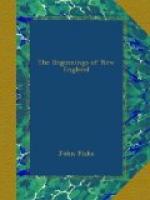This allusion to the universities may serve to introduce the very interesting topic of the geographical distribution of Puritanism in England. No one can study the history of the two universities without being impressed with the greater conservatism of Oxford, and the greater hospitality of Cambridge toward new ideas. Possibly the explanation may have some connection with the situation of Cambridge upon the East Anglian border. The eastern counties of England have often been remarked as rife in heresy and independency. For many generations the coast region between the Thames and the Humber was a veritable litus haereticum. Longland, bishop of Lincoln in 1520, reported Lollardism as especially vigorous and obstinate in his diocese, where more than two hundred heretics were once brought before him in the course of a single visitation. It was in Lincolnshire, Norfolk, Suffolk, and Essex, and among the fens of Ely, Cambridge, and Huntingdon, that Puritanism was strongest at the end of the sixteenth century. It was as member and leading spirit of the Eastern Counties Association that Oliver Cromwell began his military career; and in so far as there was anything sectional in the struggle between Charles I. and the Long Parliament, it was a struggle which ended in the victory of east over west. East Anglia was from first to last the one region in which the supremacy of Parliament was unquestionable and impregnable, even after the strength of its population had been diminished by sending some thousands of picked men and women to America. While every one of the forty counties of England was represented in the great Puritan exodus, the East Anglian counties contributed to it far more than all the rest. Perhaps it would not be far out of the way to say that two-thirds of the




